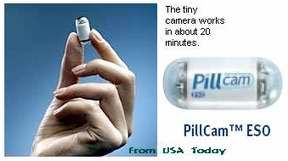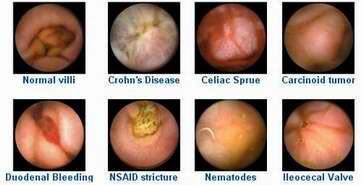
This is the PillCam™ ESO. It is a camera inside a capsule or a pill. Does it look like a James Bond device?

Well, it does look like secret agent stuff. The PillCam™ ESO (ESO for esophagus, I think) is the world's first non-invasive, diagnostic alternative to endoscopy. It has just been given marketing clearance by the US FDA this week following a large multi-center international study of the swallowable video camera.
Endoscopy for the uninitiated, is a clinical procedure in which a flexible tube (an endoscope) is inserted into the esophagus via the mouth and throat so the physician can directly examine almost any part of the intestinal tract for any abnormality or existing pathology. Through endoscopy, biopsies of select organs and tissues can be obtained, polyps can be removed, and clear images for reference can be obtained.
Endoscopy has revolutionized the field of gastroenterology. It has helped both doctor and patient in the diagnosis and treatment of many gastrointestinal tract (GIT) problems. The only catch or diasdvantage, if you can call it that, is that patients for endoscopy often require sedation and hours of recovery.
Today, gastroenterology gets another technological revolution in the form of a pill or capsule. In fact, a new subspecialty termed capsule endoscopy is emerging and is proving to be more effective and efficient than simple endoscopy.
The PillCam™ ESO is a smooth plastic capsule about the size of a large vitamin capsule that has miniature color video cameras at each end. It measures 26 millimeters wide by 11 millimeters long.
How does it work?
Will it replace endoscopy as a gastroenterologic procedure?A patient lies on his or her back and swallows the pill with water. The pill then glides down the esophageal tract taking about 2,600 color pictures (14 per second), which are transmitted to a recording device worn by the patient. After 20 minutes, the doctor has enough video images to make a definitive diagnosis. The disposable capsule is passed naturally, usually within 24 hours.
[Biocompare LifeScience News]
The PillCam will be particularly useful in diagnosing diseases of the esophagus such as gastroesophageal reflux disease (GERD), a condition described as the regurgitating of stomach acid into the food tube or esophagus which can cause cancer in 15 percent of reflux sufferers, erosive esophagitis, and Barrett's esophagus, which happens to be a pre-cancerous condition often resulting in full-blown esophageal cancer.Even so, the PillCam will not replace the endoscopy, says Blair Lewis, a gastroenterologist at Mount Sinai School of Medicine in New York. Instead, he says, the tiny camera will be used as a screening device. If the images suggest a serious problem, such as a cancerous or pre-cancerous condition, Lewis says an endoscopy still would be needed to collect tissue samples.
"What it really provides is another option for people wary of sedation and a more invasive procedure," says Robynne Chutkan of Georgetown University Hospital, spokeswoman for the American Gastroenterological Association.
[USA Today]
I'm not particularly familiar with Philippine recommendations, but the American College of Gastroenterology (ACG) recommends that patients with long-standing GERD symptoms, particularly those 50 and older, should have upper endoscopy to detect Barrett's Esophagus. Those who are self-medicate or are prescribed with antacids are strong candidates for esophageal disease evaluation either by capsule endoscopy or simple endoscopy.
The PillCam™ ESO is made by the innovative Yokne'am company, Given Imaging of Israel, which also makes the PillCam™SB, approved by the US-FDA in 2001 to detect abnormalities in the small bowel. Here are examples of real image cases taken by both the PillCam™ESO and the PillCam™ SB (small bowel):


1 reactions:
Totally awesome, To thing that something as simple as this can help without all the pain, discomfort and recovery time. It is for the benefit of mankind that such things are developed. Continued success to you all.
Thank You!
Post a Comment